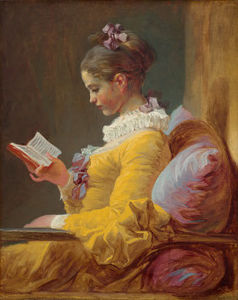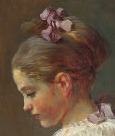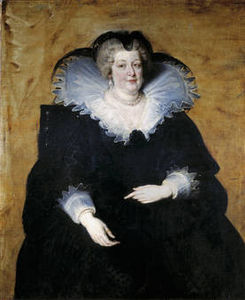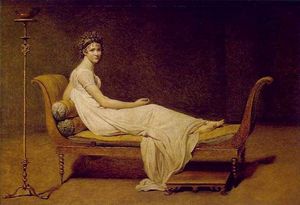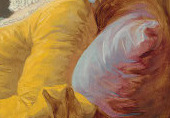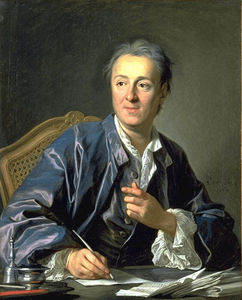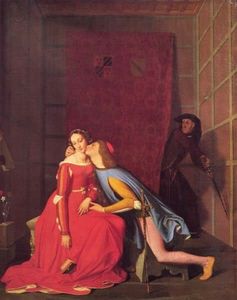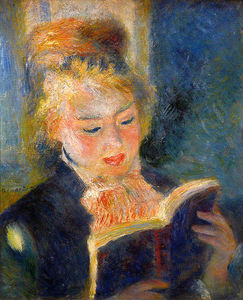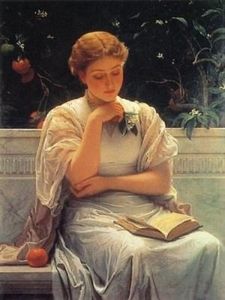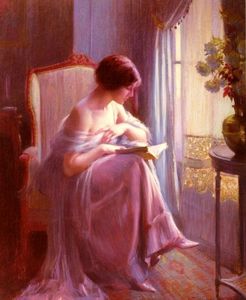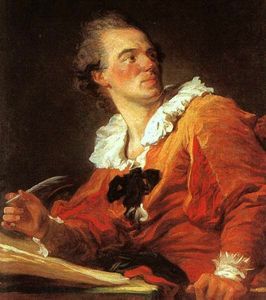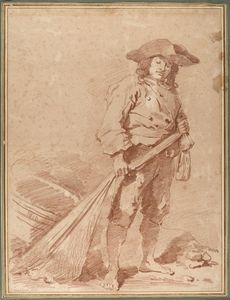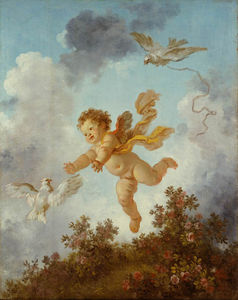Young Girl Reading
- Date of Creation:
- circa 1770
- Height (cm):
- 81.10
- Length (cm):
- 64.80
- Medium:
- Oil
- Support:
- Canvas
- Subject:
- Figure
- Framed:
- Yes
- Art Movement:
- Rococo
- Created by:
- Current Location:
- Washington, District of Columbia
- Displayed at:
- National Gallery of Art Washington
- Owner:
- National Gallery of Art Washington
- Young Girl Reading Page's Content
- Story / Theme
- Inspirations for the Work
- Analysis
- Critical Reception
- Related Paintings
- Artist
- Art Period
- Bibliography
Young Girl Reading Story / Theme
One of Jean-Honoré Fragonard's most simple yet elegant paintings, Young Girl Reading has captivated audiences throughout the ages with its warmth and sensuality.
The sitter for the portrait is unknown, and the girl herself seems to represent a larger archetype of fresh femininity; Hair swept up in a modest chignon, she sits in a position of pensive repose, delicately swathed in a sunny yellow dress and creamy frills highlighting her soft curves. The fluidity of her contours is typical of Rococo painting.
With her head inclined, the girl is deeply absorbed in the book she is reading, or perhaps her own daydream. The lack of writing instruments indicates that she reads for pleasure, rather than academic reasons.
The background in this image is simplistic which gives even greater emphasis to the girl's appearance. The tone created is one of elegant domesticity.
Fragonard's work is intended to be pleasing to the eye above all else, eschewing intellectual pursuits and bringing a sense of joy and warmth to the viewer.
Captivated by the feminine beauty of the girl or perhaps the nature of femininity in general, Fragonard is asking the viewer to question what she is reading, creating a sense of mystery within the portrait and how it may have an effect on her thoughts and emotions.
In this way the viewer is drawn into the scene, and the portrait becomes a meditation on beauty and the act of reading.
Young Girl Reading Inspirations for the Work
Inspirations for Young Girl Reading include;
Marguerite Gerard:
Marguerite was Fragonard's wife's 14-year-old sister whom he fell in love with and made his student and assistant. The subject matter of his paintings after this changed towards a more domestic and distinctly feminine treatment of portraiture.
Peter Paul Rubens:
Always a fan of the Dutch Masters, the inspiration that Rubens provided is clear in this portrait in terms of its attention to detail and loose fluid brushwork, as well as the delicate round figure of the girl. These are all reminiscent of earlier works by Rubens.
Neoclassicism:
By this time period, the frivolity and lighthearted nature of Rococo works were no longer fashionable, replaced by a more serious return to painterly technique typical of Neoclassicism.
While Fragonard never embraced the Neoclassical wholeheartedly, one can see the influence in his later works such as Young Girl Reading, which retains a more sober air about it despite its revelation of femininity.
Young Girl Reading Analysis
After getting married, Fragonard found a renewed interest in quiet domestic scenes and Young Girl Reading is one of his most successful forays into the subject.
Composition:
Fragonard supplies visual interest to the portrait's composition by juxtaposing geographical structure in the background with the soft curves and frills in the foreground, and the figure herself.
The brown wall behind the girl provides a strong vertical structure, which combined with the horizontal bar of the armrest gives solidity to the composition. By contrast, the girl herself is all softness, with great attention given to the folds of silk, frills, and ribbons that envelope her as she reclines against the rosy pillow.
Use of space:
There is a marked contrast between the solid mass of the girl and the chair in the center and right of the painting and the bare wall behind her that defines and frames the shot. This gives a feeling of depth to the image.
Color palette:
The subject's saffron dress stands out and pulls the composition together, though it is supported by other tones of gold which is typical of Rococo painting. The flesh hues are warm and rosy, as is the violet-colored pillow the girl leans against.
Darker ochre and burnt sienna give strength to the background walls and shadows, along with the mahogany arm rest. The color selections reinforce the composition and give an illusion of soft warmth that permeates the painting.
Use of light:
The contrast between light and dark is intense in this portrait, with the colors alternating between dark and pale as they follow the contours of the girl's body. A soft, diffused light is cast upon the book she is reading, causing her shadow to be thrown against the pillows she is supported by.
Mood Elicited:
The mood is one of reflection, beauty and calm. The warm tones infuse the composition with a homey sense of comfort.
Brushstroke:
To achieve the precise detail of the girl's collar Fragonard utilized a wooden brush to carve into the paint. This swordplay technique of painting yields the highly textured results.
Particularly with the girl's fingers curled in a pleasing interplay of motion around her book, one can see the swift fluidity of Fragonard's brushwork, so typical of his Rococo style.
Young Girl Reading Critical Reception
Jean Honoré Fragonard's skill in capturing the delicacies of a domestic scene and the subtleties of femininity is evident in Young Girl Reading.
Contemporary Reception:
While Fragonard received no shortage of commissions from the aristocracy in Paris, the leading thinkers of the time had more unkind reactions to his work.
His frothier works brought Fragonard harsh criticism from philosophers such as Denis Diderot, one of the foremost designers of the French Enlightenment. Diderot charged the artist with frivolity and suggested that he have "a little more self-respect. "
Rococo style fell under critical attack by 1765 and was eventually replaced by the classical ideals and severity of Neoclassicism.
Posthumous Reception:
Post-revolution, there was no room for the shallow subject matter of the Rococo artists, Fragonard's Young Girl Reading included. A great deal of his client base died during the Terror in Paris, and he was forgotten for many years. The style of his painting was forsaken in favor of cleaner lines, moral severity, and the classical subject matter of the Neoclassicists.
Modern Day Reception:
Today the work of Fragonard has been rediscovered by a generation with a taste for frivolity, particularly in the world of high fashion which thrives on the frills and moods set by portraits such as Young Girl Reading. In fact this particular painting is one of the most popular in terms of reproductions and modern home decorations.
Young Girl Reading Related Paintings
Young Girl Reading Artist
One of the artist's more haunting and reflective portraits, Young Girl Reading is a favorite among Fragonard's critics due to its hushed tone, sunny use of color, and charming subject matter.
As charming and witty as his paintings, Jean-Honoré Fragonard was one of the most prolific artists of his time, producing more than 550 works during his career. Serving as an apprentice to Chardin and Boucher, two of the premier Rococo artists he later won the Prix de Rome and attended the French Academy.
Fragonard's work came with a high pedigree and prestige and as one of the last artists of the Rococo; his name is almost synonymous with this frivolous, erotic, and decadent movement.
Reputedly one of the most prolific painters of the 18th century, if not of all time, Fragonard had a feverish output of varied subject matter. From portraits to scenes of pastoral, erotic, or domestic appeal he covered a wide range of themes.
Fragonard's work is easily recognizable due to the lightness and frivolity of the subject matter, the deft touch of the brushwork, and the soft, carefree lighting schemes.
Today Fragonard is thought of as a relic of a time past, a testament to a somewhat innocent time period before the French Revolution wiped out the aristocracy and ushered in a new era of democracy.
The Rococo has not weathered the test of time too well as far as being heralded as an artistic period that produced anything of importance. Rococo artists lived in their own bubble, much like the noble class of the day, and now their work is regarded more out of historical interest rather than artistic.
Young Girl Reading Art Period
Fragonard was a product of the later stages of the Rococo era, a time characterized by hedonistic freedom and a pursuit of all things aesthetically pleasing. The Rococo era originated from the French decorative style Racaille meaning 'decorative shell and rock work'.
Rococo was created by and for the rich of France. They wanted works that reinforced their wealth and pleasure in all beauty and splendor, as artists recreated scenes of arcadia. The Palace of Versailles was the ideal in decadent Rococo art and architecture, informed by ideas of the French Enlightenment.
A master of the domestic scene, the pastoral landscape and tongue-in-cheek eroticism of the boudoir painting, Fragonard had his share of admirers and wielded a strong influence over future masters of the art world, particularly the Impressionists. Impressionism as a movement bears similarities to the Rococo in its emphasis on fleeting moments of beauty, sudden impressions, and pleasure.
Although for a time after the Revolution Fragonard disappeared from the history of art, his wittily airy style cropped up again years later with a new legion of imitators and by the end of the 19th century there was a rediscovery of Fragonard and other Rococo artists.
Young Girl Reading Bibliography
For further information about Jean-Honoré Fragonard's contribution to the Rococo movement, please choose from the following recommended sources.
• Ashton, D. Fragonard in the Universe of Painting. Prentice Hall & IBD, 1988
• Cuzin, Jean-Pierre. Fragonard: Life and Work. Harry N. Abrams, Inc. , 1988
• Dupuy-Vachey, Marie-Anne. Fragonard. Pierre Terrail, 2006
• Molotiu, Andrei. Fragonard's Allegories of Love. J Paul Getty Trust Publications, 2008
• Massengale, Jean Montague. Fragonard (Masters of Art). Harry N. Abrams, Inc. , 1998
• Rosenberg, Pierre. Fragonard: Metropolitan Museum of Art. Harry N. Abrams, Inc. , 1988
• Rosenberg, Pierre. From Drawing to Painting: Poussin, Watteau, Fragonard, David, and Ingres (A. W. Mellon Lectures in the Fine Arts). Princeton University Press, 2000
• Sheriff, Mary D. Fragonard: Art and Eroticism. University of Chicago Press; 2nd edition, 1990

